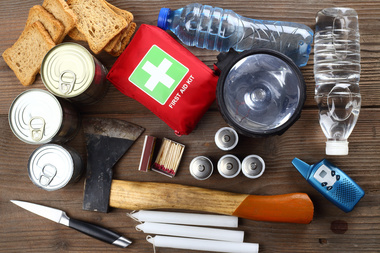Are you prepared if a disaster were to strike your area? Experts say you need enough food, water and supplies to last for at least 72 hours. Do you know what you need in your emergency kit to last three days or more? Here’s how to be prepared by creating an emergency kit.
7 Things You Need in Your Emergency Kit
Water ”“ Water is the most important thing you will need in your emergency kit, but it is also the hardest to store. After a storm blows through, you may only have the water in your emergency kit to drink. Your regular water source could be contaminated and there may not be any electricity to run water. You’ll need water to bathe, drink and flush toilets. Store at least one gallon of water per person per day. Bottled water is best.
Food ”“ Canned soup and vegetables, boxed cereal, crackers and other nonperishable food should be included in your emergency kit. Store at least three days’ worth of food. Don’t pack foods with a lot of sodium that will make you thirsty.
First Aid Kit ”“ You should have a first aid kit to treat minor injuries. Bandages, ointment, burn ointment and other supplies should be in your first aid kit. You should also keep prescription medication doses in your kit in case you can’t access a drug store. Also stock up on over-the-counter pain medications.
Flashlights ”“ If your power goes out during a storm, you will need to have some form of lighting. Keep flashlights handy in your emergency kit, along with batteries to power them.
Sleeping Bags/Blankets ”“ Every person in your home should have a blanket, especially if you live in a colder area. Keep extra clothing as a part of your emergency kit as well. Store pillows and bedding for extra comfort during and after the storm.
Cash ”“ After a storm, banks may not be open and ATMs may not work. Keep cash and traveler’s checks in your emergency kit. Before a storm hits, be sure to go to the bank or ATM and withdraw money. Some businesses may reopen after a storm even if they don’t have power, but without power, your credit cards will be useless to purchase anything.
Utensils ”“ You don’t want to be using your fingers to dig in cans to eat. Make sure you have packed utensils in your emergency kit so that you can eat comfortably after a storm.
What else would you include in your emergency kit?


